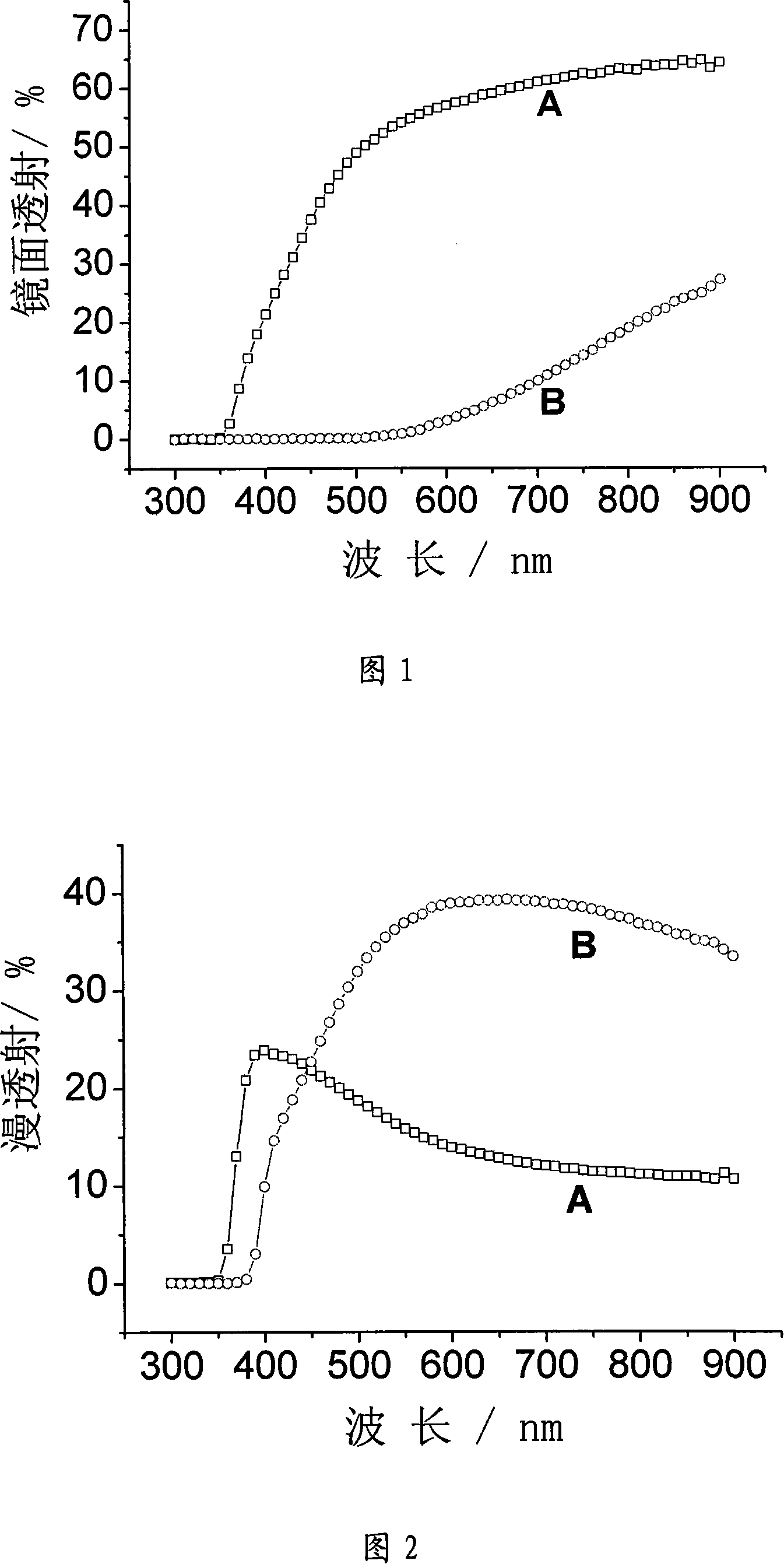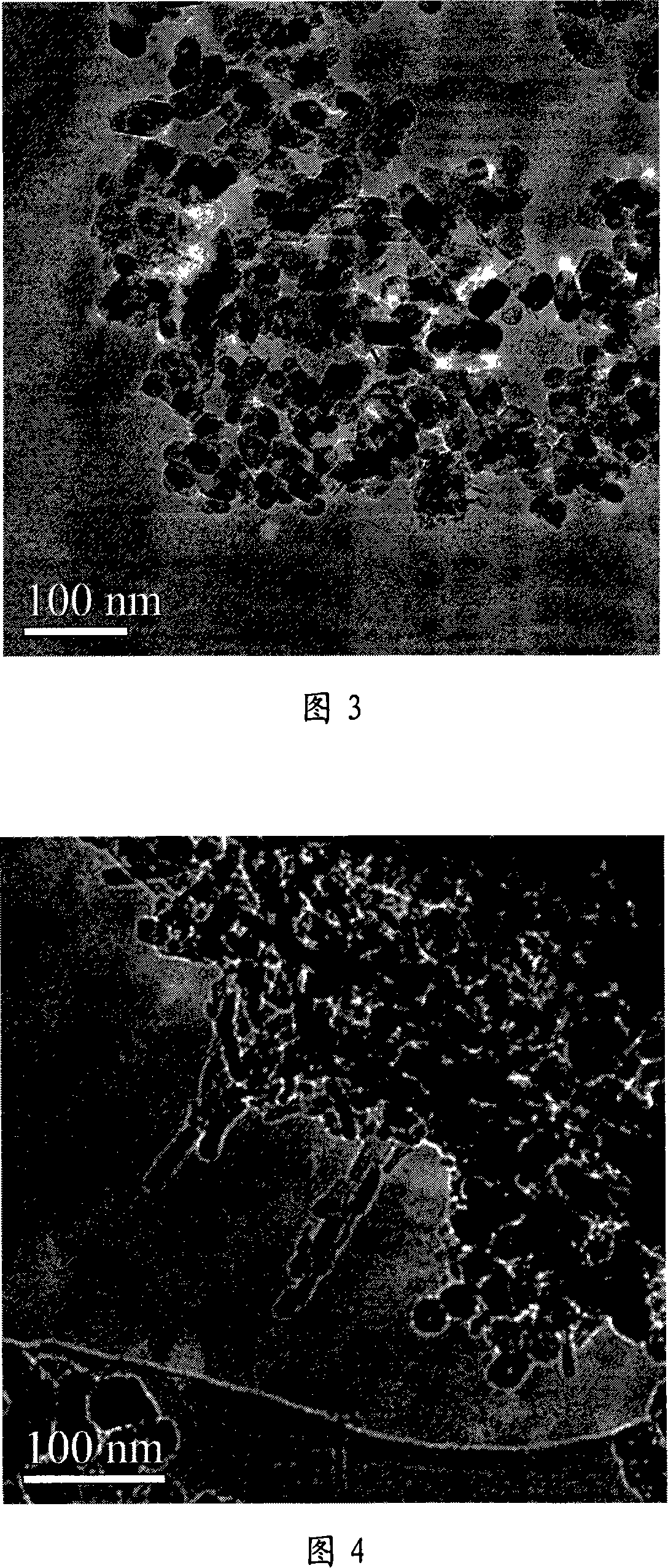Dye sensitization solar cell based on titanic oxide nano bar light scattering thin film electric pole and its preparing method
A solar cell, titanium dioxide technology, applied in photosensitive equipment, photovoltaic power generation, electrolytic capacitors and other directions, can solve the problems of short circuit of battery and enlarged pores of photoanode film, and achieve the effect of simple operation, easy industrial production and high light scattering performance.
- Summary
- Abstract
- Description
- Claims
- Application Information
AI Technical Summary
Problems solved by technology
Method used
Image
Examples
Embodiment 1
[0040] (1) Clean the surface of the conductive substrate. Use indium tin oxide conductive glass as the conductive substrate, use ethanol / acetone mixed solvent to ultrasonically clean the surface of the conductive substrate for 15 minutes, then put it into deionized water with detergent for ultrasonic cleaning for 15 minutes, then put it into deionized water for 15 minutes and rinse it three times Finally, place the conductive substrate in a clean bench and dry it with an infrared lamp.
[0041] (2) Preparation of titanium precursor solution: 3 mL of tetraisopropyl titanate was dissolved in 100 mL of petroleum ether to prepare a tetraisopropyl titanate petroleum ether solution with a concentration of 3% by volume.
[0042] (3) Dense TiO 2 Preparation of primary semi-finished products for thin film electrodes. Tape both sides of the washed and dried conductive substrate to leave a blank portion for the lead electrodes. Then immersed in a 3% titanium precursor solution, soaked...
Embodiment 2
[0053] According to the method in Example 1, except that the following steps are modified, other steps are identical.
[0054] When preparing the titanium precursor solution, 7 mL of tetrabutyl titanate was dissolved in 100 mL of cyclohexane to prepare a 7% tetrabutyl titanate cyclohexane solution by volume.
[0055] When preparing titanium dioxide small particle colloids, heat them in a titanium autoclave at 230°C for 14 hours to obtain TiO with a particle size of 30nm and a final solid content of 20%. 2 Colloidal small particles.
[0056] During the preparation of titanium dioxide nanorods, after ultrasonication at 300W for 1h, the temperature was kept in a 120°C hydrothermal kettle for 36h, and the lower sediment was kept in a muffle furnace at 550°C for 2h.
[0057] TiO2 nanorod light-scattering thin film electrode preparation, TiO 2 The weight percentage of the nanorods and the small titanium dioxide particles is 20%. The first layer of dense TiO 2 The thickness of th...
Embodiment 3
[0059] According to the method in Example 1, except that the following steps are modified, other steps are identical.
[0060] When preparing the titanium precursor solution, 1 mL of tetraisopropyl titanate was dissolved in 100 mL of n-butyl ether to prepare a 1% tetraisopropyl titanate n-butyl ether solution.
[0061] When preparing titanium dioxide small particle colloids, heat it in a titanium autoclave at 230°C for 12 hours to obtain TiO with a particle size of 25nm and a final solid content of 15%. 2 Colloidal small particles.
[0062] During the preparation of titanium dioxide nanorods, after ultrasonication at 400W for 3h, they were placed in a 120°C hydrothermal kettle for 48h, and the lower layer of sediment was kept at a constant temperature for 2h in a muffle furnace at 500°C.
[0063] When the titanium dioxide nanorod light-scattering film electrode is prepared, the weight percentage of the nanorod and the titanium dioxide small particle is 15%. The first layer o...
PUM
| Property | Measurement | Unit |
|---|---|---|
| Particle size | aaaaa | aaaaa |
| Diameter | aaaaa | aaaaa |
| Length | aaaaa | aaaaa |
Abstract
Description
Claims
Application Information
 Login to View More
Login to View More - R&D
- Intellectual Property
- Life Sciences
- Materials
- Tech Scout
- Unparalleled Data Quality
- Higher Quality Content
- 60% Fewer Hallucinations
Browse by: Latest US Patents, China's latest patents, Technical Efficacy Thesaurus, Application Domain, Technology Topic, Popular Technical Reports.
© 2025 PatSnap. All rights reserved.Legal|Privacy policy|Modern Slavery Act Transparency Statement|Sitemap|About US| Contact US: help@patsnap.com



